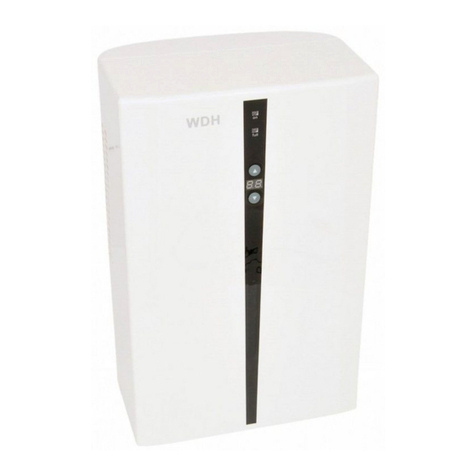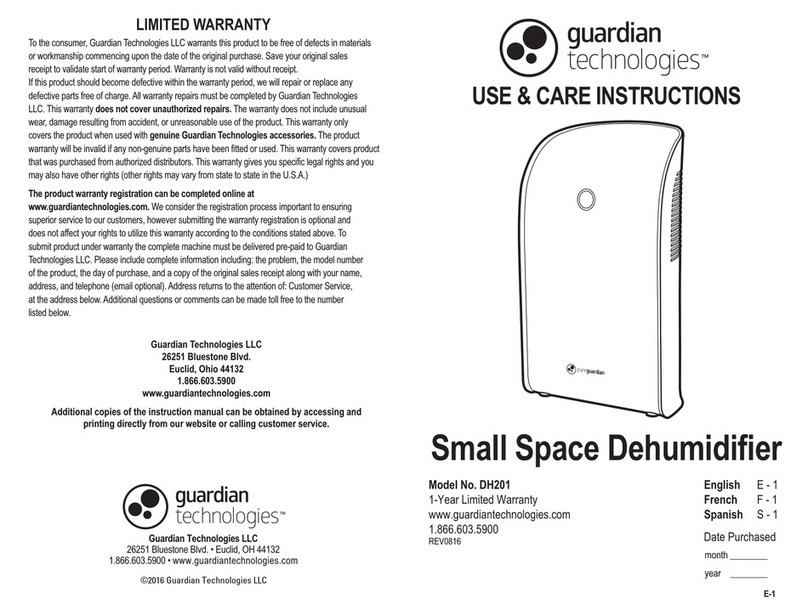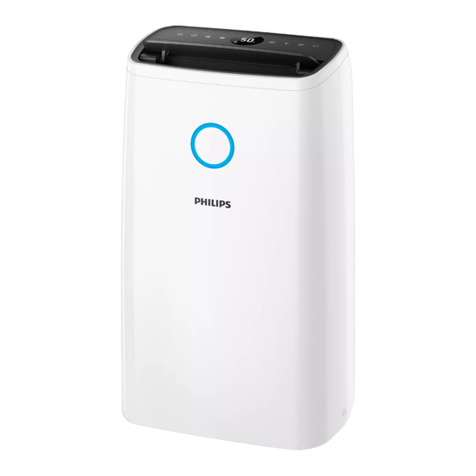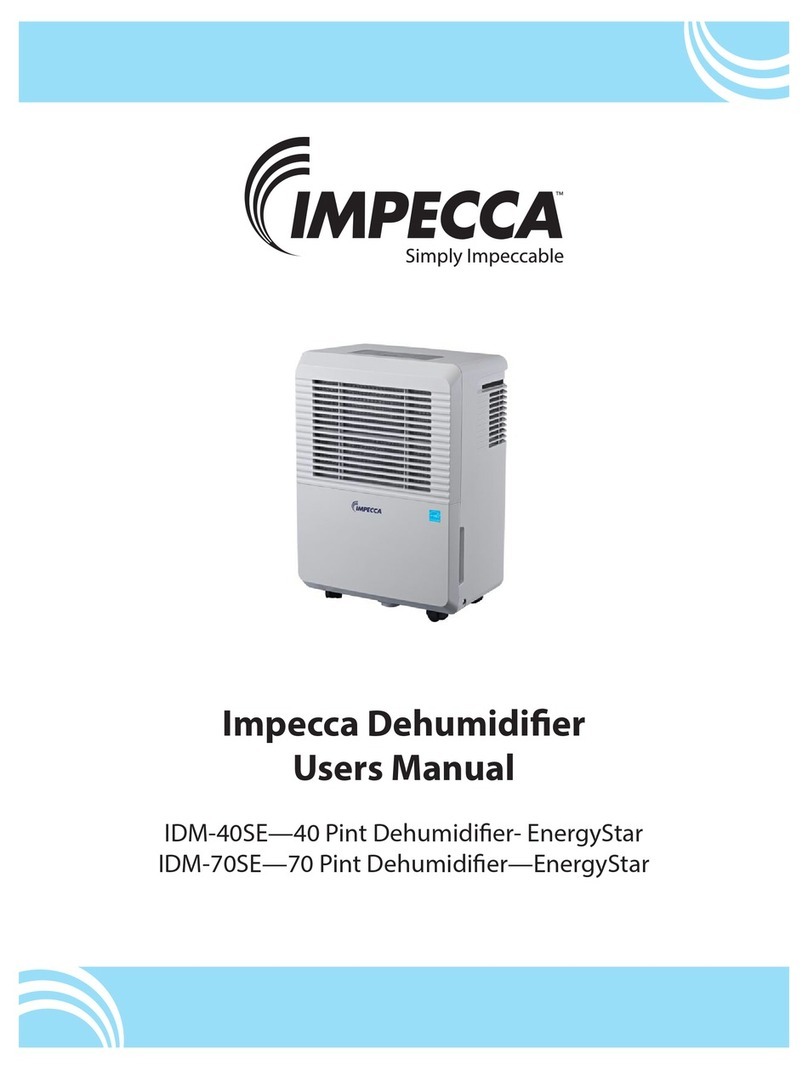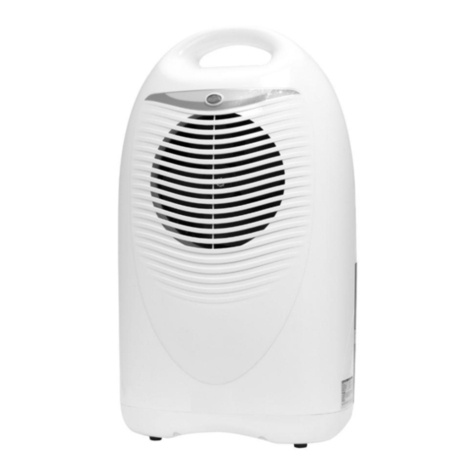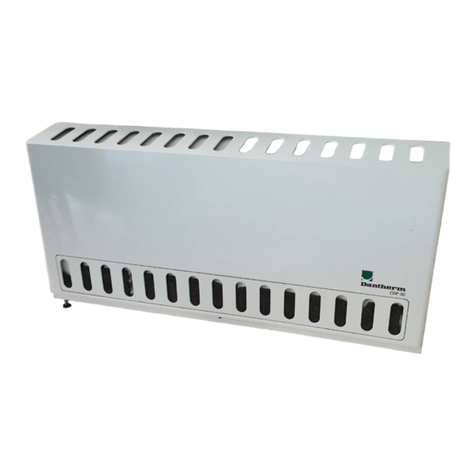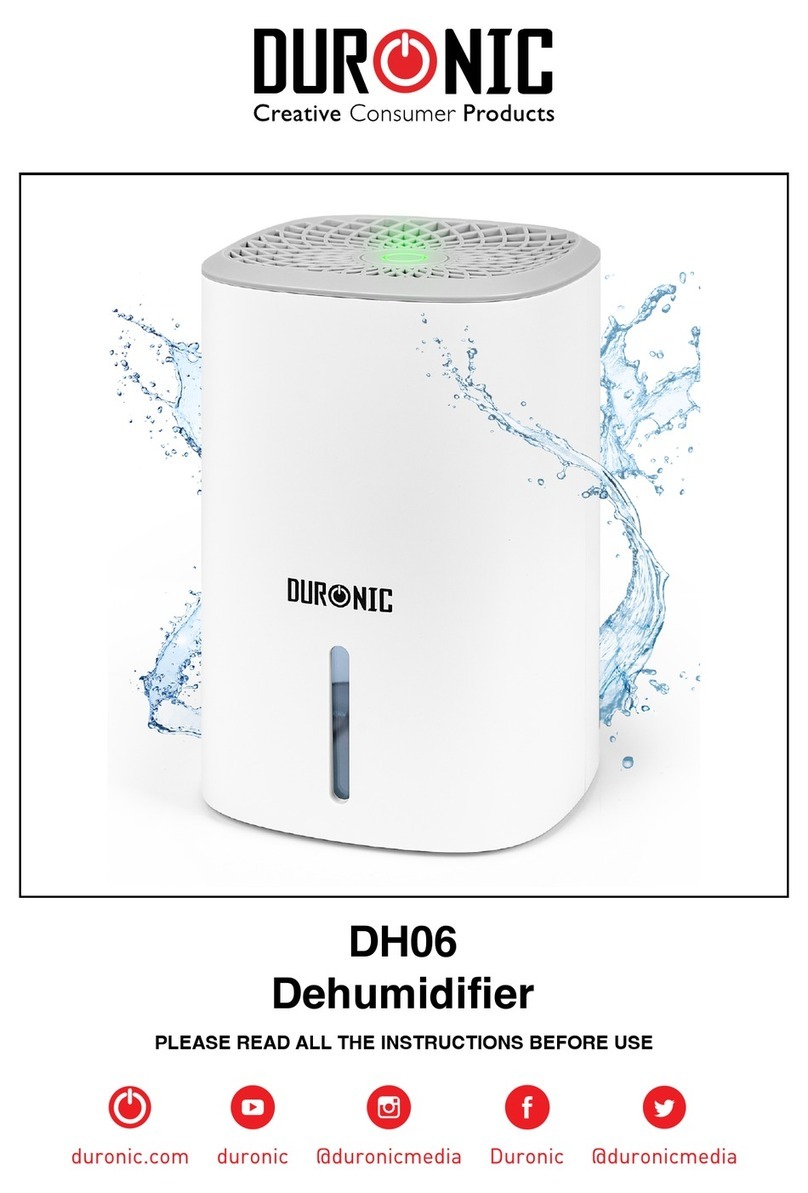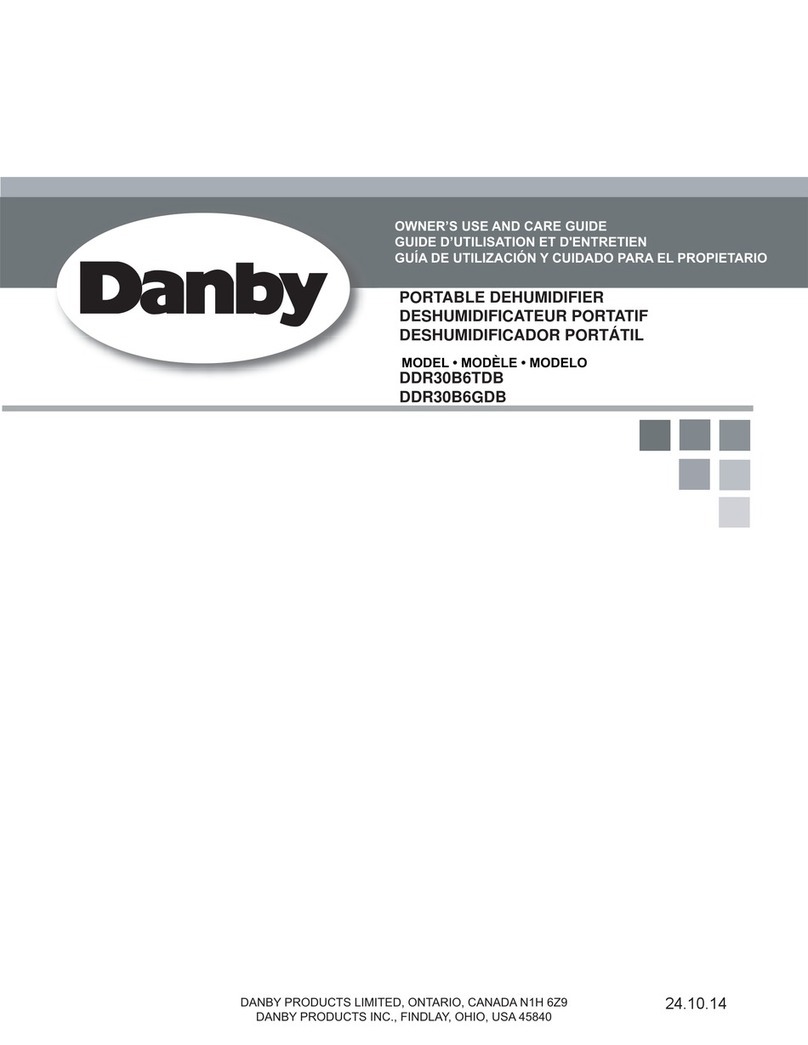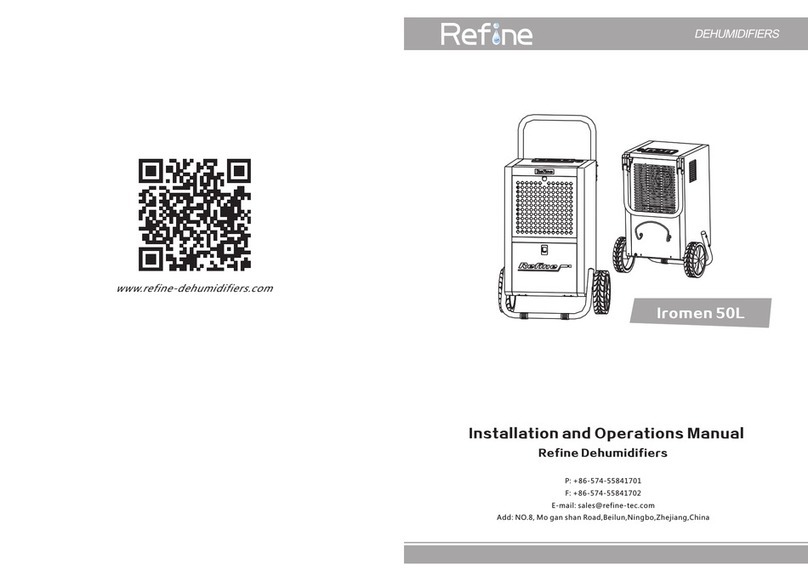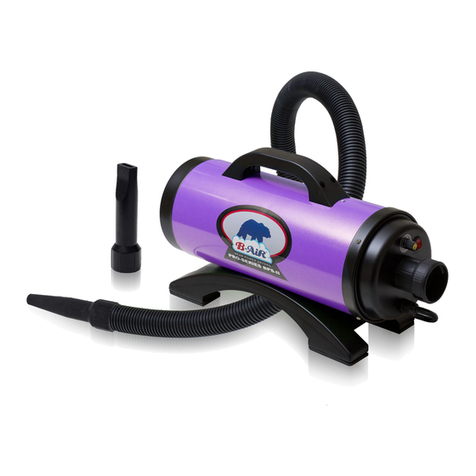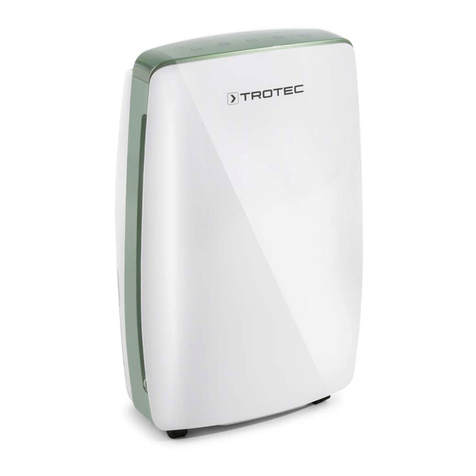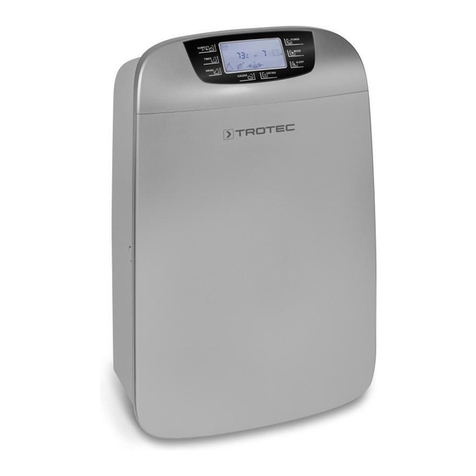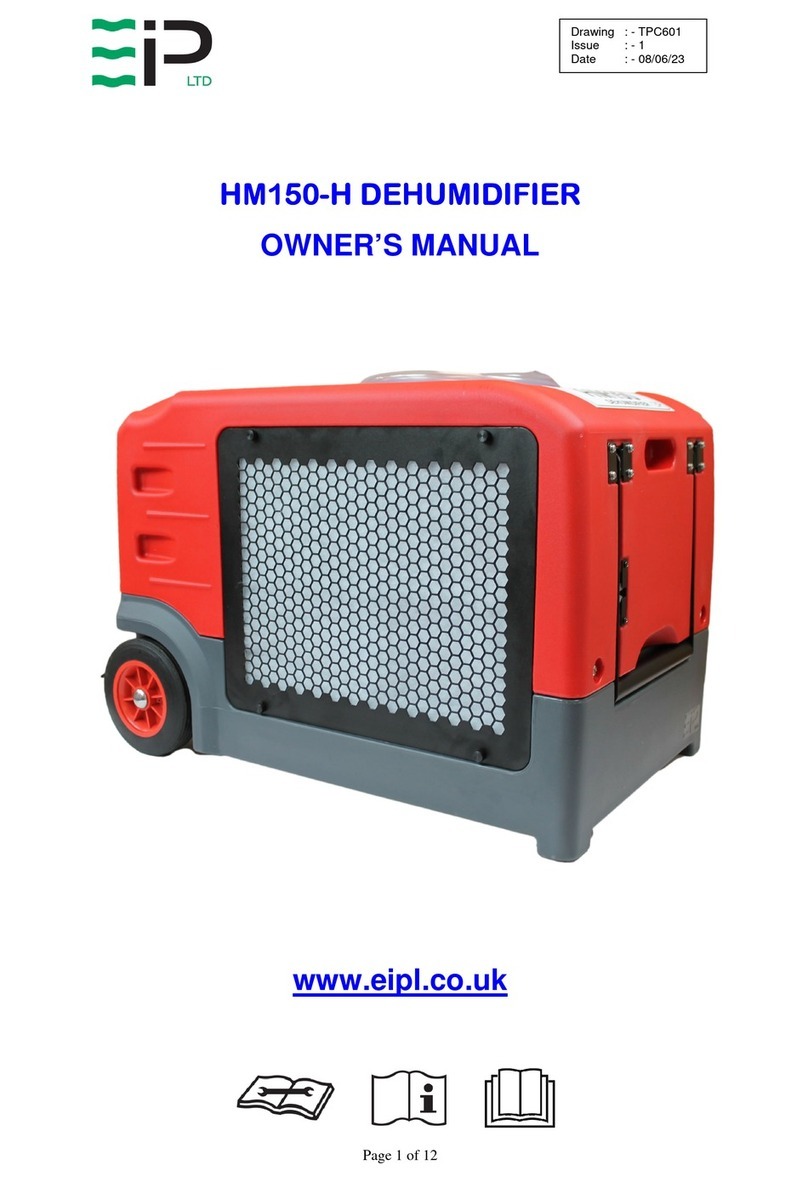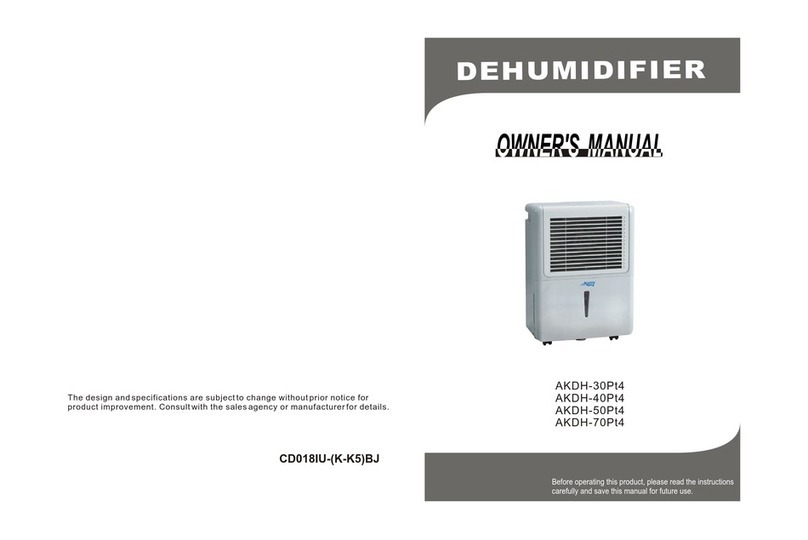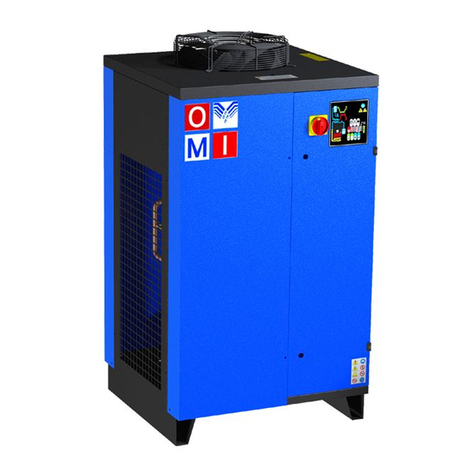BENDIX AD-1 Mounting instructions

1
Bendix AD-1™ and AD-2 Air Dryers
SD-08-2403
Figure 1 – Bendix®AD-1™and AD-2®Air Dryers
BENDIX®AD-2®AIR DRYER
BENDIX®AD-1™AIR DRYER
DESCRIPTION
The air dryer collects and removes moisture and
contaminants before the air reaches the •rst reservoir. It is
distinctly different than a reservoir drain valve or aftercooler
in that it provides “dry air” for the air brake system. The daily
draining of the system’s reservoirs is no longer necessary,
thus reducing maintenance considerably when compared
to an air brake system without an air dryer.
In a system without an air dryer, the life of air brake
components is substantially reduced because of contact
with water and oil in the system, and – since the air dryer
removes water and oil in vapor form– life of the component
devices is substantially increased when the air dryer is
used.
The air dryer can be used on most highway vehicles where
normal compressor loaded time is 90 seconds or less and
unloaded time is 30 seconds or more. If the compressor
remains loaded for long periods of time, such as on a transit
bus, certain changes in the purge volume of the dryer
must be made. For more information regarding increase
of the purge volume, contact the Bendix TechTeam at
1-800-AIR-BRAKE (1-800-247-2725).
The air dryer is installed in the discharge line between
the compressor and the •rst reservoir. The unit must be
mounted vertically and mounting brackets – which can be
adjusted to meet installation requirements – are provided.

2
Figure 2 – Sectional Views
BENDIX®AD-1™AIR DRYER
The housing assembly consists of two cylindrical steel
stampings welded together. For piping convenience, two
inlet ports – one reservoir port and one purge volume
port – are provided in the Bendix®AD-2®air dryer. The side
outlet port of the AD-2 air dryer incorporates an integral
single check valve with the top port used for the addition
of purge volume. (Refer to Figure 2.)
A safety valve mounted in the housing assembly protects
against excessive pressure build-up within the housing.
The desiccant sealing plate assembly is located mid-way in
the housing assembly and houses a replaceable ball-type
single check. Also located in the plate assembly is the
purge ori!ce.
The desiccant cartridge and aluminum oil separator !lter
are removable and comprise a complete serviceable unit.
The desiccant beads, which are referred to as the “drying
bed”, are a drying substance that has the unique property
of exposing a tremendous surface area in proportion to
its bulk. One pound of the desiccant beads has about two
million square feet of adsorptive area made up of a large
number of submicroscopic cavities in each bead. Each
desiccant bead adsorbs or collects moisture.
The desiccant beads are held in place by steel perforated
plates and !lter cloths. The top plate is held in place
by a spring, and the bottom plate rests on a shoulder
approximately 1/8” from the bottom of the cartridge housing.
BENDIX®AD-2®AIR DRYER
5-1/2”
19-1/2”
PURGE
VOLUME
PURGE
ORIFICE
INLET
DESICCANT
“O” RING
HEATER
PURGE
VALVE EXHAUST
DEFLECTOR
RETAINING
RING
OIL
FILTER
MOUNTING
BRACKET
SAFETY
VALVE
“O” RING
“O” RING
CHECK
VALVE
LOCK
NUT
MOUNTING
BRACKET
OUTLET
CHECK
VALVE
OUTLET
LOCK
NUT
SPRING
RETAINER
PERFORATED
PLATE
OIL
FILTER
HEATER
THERMOSTAT
ENCLOSURE
ELECTRICAL
TERMINAL
PURGE
VALVE
CONTROL
PORT
PURGE
VALVE
PISTON
DESICCANT
CARTRIDGE
CARTRIDGE
BOLT
INLET
DESICCANT
SEALING
PLATE

3
The end cover assembly is retained by a lock ring, as well
as cap screws and retainers, and houses the purge valve
and heater assembly if so equipped.
The heater and thermostat assembly prevent freeze-up
in the purge drain valve when the dryer is used in severe
winter conditions. The heater and thermostat assembly is
standard in the Bendix®AD-2®air dryer and was optional
equipment for the Bendix®AD-1™air dryer. The 12 volt / 60
watt and 24 volt / 60 or 120 watt DC heater and thermostat
assembly has an operating range between 45°F and 85°F.
NOTE: The heater and thermostat assembly provided with
the AD-2 air dryer has a 3/16” diameter threaded electrical
terminal protected by a boot. The AD-1 air dryer assembly
incorporates a #16 gauge lead wire. Both types are
serviceable. The heater and thermostat assembly should
be connected to the “on” position of the engine control or
ignition switch and protected with the proper size fuse.
For details on installation, please refer to the “Installation”
section.
OPERATION
The operation of the air dryer can best be described by
separating the operation into two cycles; the charge cycle
and the purge cycle.
Charge Cycle: (See Figure 3.) A compressor in the
compressing cycle - With the compressor in its “loaded”
or compressing cycle, air from the compressor enters the
air dryer through the discharge line. When the air – along
with the water and contaminants – enters the air dryer, the
velocity or speed of the air reduces substantially and much
of the entrained liquid drops to the bottom (or sump) of
the air dryer. The initial air !ow is toward the bottom of the
dryer, but air !ow direction changes 180° at the bottom of
the air dryer, dropping some water and oil.
The air now passes through the oil separator "lter which
removes oil and foreign material but does not remove water
vapor. At this point, the air remains saturated with water.
The "ltered air and vapors penetrate the desiccant drying
bed and the adsorption process begins. Water vapor is
removed from the air by the desiccant.
The unsaturated “dry” air passes through the ball check
valve and purge ori"ce into the purge volume. From the
purge volume air !ows through an outlet check valve, and
into the "rst reservoir.
NOTE: The AD-1 air dryer does not incorporate an integral
outlet check valve. The single check valve in an AD-1 air
dryer installation would be located in the line between the
AD-1 air dryer outlet port and the !rst reservoir.
GENERAL SAFETY GUIDELINES
WARNING! PLEASE READ AND
FOLLOW THESE INSTRUCTIONS
TO AVOID PERSONAL INJURY OR DEATH:
When working on or around a vehicle, the following
guidelines should be observed AT ALL TIMES:
▲Park the vehicle on a level surface, apply the parking
brakes and always block the wheels. Always wear personal
protection equipment.
▲Stop the engine and remove the ignition key when working
under or around the vehicle. When working in the engine
compartment, the engine should be shut off and the ignition
key should be removed. Where circumstances require that
the engine be in operation, EXTREME CAUTION should be
used to prevent personal injury resulting from contact with
moving, rotating, leaking, heated or electrically-charged
components.
▲Do not attempt to install, remove, disassemble or
assemble a component until you have read, and thoroughly
understand, the recommended procedures. Use only the
proper tools and observe all precautions pertaining to use
of those tools.
▲If the work is being performed on the vehicle’s air brake
system, or any auxiliary pressurized air systems, make
certain to drain the air pressure from all reservoirs before
beginning ANY work on the vehicle. If the vehicle is
equipped with a Bendix®AD-IS®air dryer system, a Bendix®
DRM™dryer reservoir module, or a Bendix® AD-9si®air
dryer, be sure to drain the purge reservoir.
▲
Following the vehicle manufacturer’s recommended
procedures, deactivate the electrical system in a manner
that safely removes all electrical power from the vehicle
.
▲Never exceed manufacturer’s recommended pressures.
▲Never connect or disconnect a hose or line containing
pressure; it may whip and/or cause hazardous airborne
dust and dirt particles. Wear eye protection. Slowly open
connections with care, and verify that no pressure is
present. Never remove a component or plug unless you are
certain all system pressure has been depleted.
▲Use only genuine Bendix®brand replacement parts,
components and kits. Replacement hardware, tubing, hose,
fittings, wiring, etc. must be of equivalent size, type and
strength as original equipment and be designed specifically
for such applications and systems.
▲Components with stripped threads or damaged parts should
be replaced rather than repaired. Do not attempt repairs
requiring machining or welding unless specifically stated
and approved by the vehicle and component manufacturer.
▲Prior to returning the vehicle to service, make certain all
components and systems are restored to their proper
operating condition.
▲For vehicles with Automatic Traction Control (ATC), the ATC
function must be disabled (ATC indicator lamp should be
ON) prior to performing any vehicle maintenance where
one or more wheels on a drive axle are lifted off the ground
and moving.
▲The power MUST be temporarily disconnected from the
radar sensor whenever any tests USING A DYNAMOMETER
are conducted on a vehicle equipped with a Bendix®
Wingman®system.
▲You should consult the vehicle manufacturer's operating
and ser vice manuals, and any related literature, in
conjunction with the Guidelines above.

4
Figure 3 – Bendix®AD-2®Air Dryer Operational Purge Cycle
Figure 4 – Bendix AD-2 Air Dryer Operational Purge Cycle
- AIR PRESSURE
- AIR PRESSURE

5
Figure 5 – Ball Check Valve
Purge Cycle: (See Figure 4.) When the desired system
pressure is reached, the governor cuts-out, pressurizing
the unloader cavity of the compressor which unloads the
compressor (non- compressing cycle). The line connecting
the governor unloader port to the end cover purge valve
port (bottom of the air dryer) is also pressurized, opening
the exhaust of the purge valve to atmosphere. With the
exhaust of the purge valve open, contaminants in the
discharge line and dryer sump are purged, or forced past
the open exhaust out to atmosphere.
The reverse air !ows across the desiccant and starts the
removal process of moisture from the desiccant surface.
Dry air !owing from the purge volume through the purge
ori"ce and across the drying bed further dries the desiccant.
The combination of these reverse !ows strips the water
vapor from the desiccant (drying bed). This normally takes
between 15–30 seconds.
The desiccant becomes activated from this cycle and is
now ready for another charge cycle, which occurs when
the compressor returns to the compressing cycle. It is for
this reason the air dryer must be purged for 30 seconds
after receiving moisture-saturated air for a maximum of 90
seconds from a 12 CFM compressor.
This air dryer is intended to remove moisture and other
contaminants normally found in the air brake system. Do
not inject alcohol, anti-freeze, or other de-icing substances
into, or upstream of, the air dryer. Alcohol is removed by
the dryer, but reduces the effectiveness of the device to
dry air. Use of other substances can damage the air dryer
and may void the warranty.
PREVENTIVE MAINTENANCE AND CHECKING
SERVICEABILITY
IMPORTANT
Review the warranty policy before performing any intrusive
maintenance procedures. An extended warranty may be
voided if intrusive maintenance is performed during this
period.
Every 900 operating hours, or 25,000 miles, or every three
(3) months:
1. Check for moisture in the air brake system by opening
reservoirs, drain cocks, or valves, and look for the
presence of water. If moisture is present, the desiccant
may require replacement; however, the following
conditions can also cause water accumulation and
should be considered before replacing the desiccant:
A. An outside air source has been used to charge the
system. This air did not pass through the drying
bed.
B. Air usage is exceptionally high and not normal for
a highway vehicle. This may be due to accessory
air demands or some unusual air requirement that
does not allow the compressor to load and unload
(compressing and non-compressing cycle) in a
normal fashion. Check for high air system leakage.
C. The air dryer has been installed in a system that
has been previously used without an air dryer. This
type of system will be saturated with moisture and
several weeks of operation may be required to dry
it out.
D. Location of the air dryer is too close to the air
compressor. Refer to “Installation” section.
E. In areas where more than a 30° range of
temperature occurs in one day, small amounts
of water can accumulate in the air brake system
due to condensation. Under these conditions, the
presence of small amounts of moisture is normal
and should not be considered as an indication that
the dryer is not performing properly.
Note also that a small amount of oil in the system
may be normal and should not, in itself, be
considered a reason to replace the desiccant; oil
stained desiccant can often function adequately.
2. Check mounting bolts for tightness.
3. Check the operation of the integral single check valve
in the Bendix®AD-2®air dryer or the “in line” check
valve used with the Bendix®AD-1™air dryer. Build the
air system to governor cut-out and observe the test
air gauge installed in the #1 reservoir. A rapid loss of
pressure could indicate a failed check valve. This can
be con"rmed by checking at the purge valve exhaust.

6
Note: Purge valve will be open when governor cut-out
pressure is reached. Allow two minutes for purge cycle
before testing the check valve.
4. Check for excessive leakage at the purge valve by
coating the exhaust with a soap solution while the
compressor is loaded (compressing air).
5. Check the operation of the safety valve by pulling
the exposed stem while the compressor is loaded
(compressing air). There must be an exhaust of air while
the stem is held and the valve should re-seat when the
stem is released.
6. Check all lines and •ttings leading to and from the air
dryer for leakage and integrity.
7. Check the operation of the end cover heater and
thermostat assembly during cold weather operation as
follows:
A. Electric Power to the Dryer
With the ignition or engine control “on”, check
for power at the dryer’s electrical terminal with a
voltmeter or test light. (See Figure 16.) If there is
no voltage, look for a blown fuse, broken wires, or
corrosion in the vehicle wiring harness.
B. Thermostat and Heater
1. Turn off the ignition switch and cool the
end cover assembly to below 40°F. With an
ohmmeter, check the resistance between the
electrical terminal and the aluminum of the end
cover. (See Figure 16.)
This resistance should be 2.0–4.0 ohms for a
12 volt end cover; 8.1–13 ohms for a 24 volt/ 60
watt end cover; and 4.0–7.0 ohms for a 24
volt /120 watt end cover.
2. Warm the end cover assembly to over 90°F and
check the resistance as above. This resistance
should exceed 1,000 ohms.
If these resistances are within the limits, the
thermostat and heater are operating properly.
If these resistances are outside the limits,
proceed to Step C to determine the cause.
C. Heater Element
With the ignition or engine control switch “off”,
remove the thermostat cover. (See Figure 17.)
With an ohmmeter, check the resistance between
the aluminum of the end cover and the heater post.
For a 12 volt end cover, the resistance should be
2.0–2.8 ohms. For a 24 volt / 60 watt end cover,
8.1–11.1 ohms; and for a 24 volt / 120 watt end
cover, 4.0–4.6 ohms. If the heater resistance is
outside these ranges, a new or remanufactured end
cover should be installed, since the heater element
cannot be serviced.
If the heater resistance is within the limits the
thermostat should be replaced (Kit Number
102657N) or a new or remanufactured end cover
installed.
D. Reassembly
Reinstall the thermostat cover as shown in
Figure 17. Use care to ensure the rubber spacer
and the gasket are correctly installed.
8. Every 7,200 hours, 200,000 miles, or every 24 months,
change the desiccant cartridge.
NOTE: The desiccant change interval may vary from
vehicle to vehicle. Although typical desiccant cartridge
life is two years, many will perform adequately for three
to four years. In order to take maximum advantage of
desiccant life and ensure that replacement occurs only
when necessary, it is important that Serviceability Checks
1–7 be performed.
REPLACING OR REBUILDING THE BENDIX®
AD-1™AND AD-2®AIR DRYER
GENERAL
If, after completing the routine serviceability tests, it has
been determined that one or more components of the air
dryer requires replacement or maintenance, refer to page
13 to identify the appropriate kit(s) needed. When rebuilding
or replacing components of the air dryer, use only genuine
Bendix®replacement parts or kits.
REMOVAL OF THE DESICCANT CARTRIDGE
1. Loosen the air line to the control port of the air dryer
and allow the trapped air to escape to atmosphere.
After the air escapes, remove the control line from the
air dryer.
2. Loosen the delivery line from the delivery port or outlet
of the air dryer. After the pressure drops, remove the
delivery line. Loosen the delivery check valve from
this port to relieve any trapped air above the desiccant
plate assembly. If the AD-1 air dryer has an external
check valve at the delivery port, loosen it to relieve air
pressure.
3. Disconnect the heater wire.
4. Remove any exhaust silencers or the exhaust check
valve cover from the base of the air dryer. Using a hex
socket and wrench, loosen the purge valve assembly
and allow any trapped air to escape. Slowly unscrew
the purge valve and remove it.
5. Check all ports to ensure that air is not trapped in the
air dryer by powdered desiccant material.

7
Figure 7 – Replacement Desiccant CartridgeFigure 6 – Desiccant Sealing Plate
Air Dryer End Cover Removal Procedure
The Bendix®AD-2®air dryer cartridge contains a high
spring load. When replacing the AD-2 air dryer cartridge, or
performing any maintenance requiring end cover removal,
follow the procedure outlined below.
End Cover Removal
1. Loosen the three cap screws on the end cover and
turn the retaining clamps aside (cap screws may be
left !nger tight).
2. Locate the notch in the air dryer shell. While pushing
the end cover up into the dryer, insert the blade of a
screwdriver in the notch and slowly pry out the retaining
ring. If the cartridge bolt has loosened, the cartridge
spring may exert a force on the end cover retaining
ring making removal of the retaining ring and end
cover dif!cult. This spring force will prohibit the end
cover moving up into the dryer shell when pushed up.
Warning: This same force can also cause the end
cover to come out of the air dryer shell unexpectedly
during the removal process. Exercise extreme caution
to prevent bodily injury.
3. Do not stand or lay directly under the end cover while
servicing. Ensure adequate clearance between the
end cover and other surfaces to prevent hand injury if
the end cover dislodges rapidly during removal. NOTE:
Be certain the desiccant sealing plate assembly comes
out with the cartridge.
Before attempting to remove the desiccant sealing plate,
measure the cartridge bolt from the top of the desiccant
plate lock nut to the end of the bolt threads. If that
measurement is approximately 3-3/16 inches, proceed
with the disassembly.
If the bolt measures approximately 1-9/16 inches,
disassemble using CAUTION. Approximately 75 pounds
of spring force will remain against the desiccant plate
when the lock nut reaches the end of the bolt thread and
is removed.
REMOVING AND REBUILDING THE AIR DRYER
DESICCANT SEALING PLATE
Before the desiccant cartridge can be replaced or
rebuilt, the desiccant sealing plate must be removed. It
is recommended that all non-metallic parts be replaced
when the plate is removed. In the past, three methods have
been employed to secure the desiccant sealing plate to the
desiccant cartridge: a TruArc®retaining ring; two special
thin nuts; and the latest method – a single hex lock nut.
Removing the securing device will permit the desiccant
plate to be separated from the desiccant cartridge. After
removing the desiccant cartridge:
1. Remove the two o-rings from the desiccant plate and
discard them.
2. Remove the ball check valve retaining clip and remove
and discard the rubber ball valve.
3. Clean the desiccant plate thoroughly using a quality
commercial solvent, making sure the purge ori!ce and
check valve seat are clean.
4. Install a new ball check valve and replace the retaining
clip and screw. (See Figure 5.)

8
REBUILDING THE DESICCANT CARTRIDGE
IMPORTANT
Only the current revision desiccant cartridges can be
rebuilt. (See Figure 7.) Current revision desiccant cartridges
are identi!ed positively by the Bendix trademark BW
stamped in the hex head of the cartridge bolt, and by
“AD-2” displayed on the bottom face of the oil !lter. If an
old revision desiccant cartridge is removed from the
air dryer, it should be replaced with a complete current
revision desiccant cartridge.
Figure 9 – Oil Separator
Figure 10 – Cartridge Bolt Installation
Figure 8 – Desiccant Cartridge Assembly
5. Thoroughly lubricate the two new o-rings and install
them in their respective grooves in the purge plate.
(See Figure 6.)
6. Set the desiccant sealing plate aside for reinstallation
on the desiccant cartridge.
REINSTALLING THE DESICCANT CARTRIDGE IN
THE AIR DRYER
If the desiccant cartridge is to be replaced as an assembly
rather than rebuilt (see the desiccant cartridge rebuilding
instructions), remove the cartridge from the air dryer.
The current revision replacement desiccant cartridge is
shown in Figure 7. All prior revisions of the cartridge will
interchange with no modi!cations to either air dryer.
Prior to installing the new replacement cartridge in the air
dryer, the following steps must be followed:
1. Carefully remove the lock nut from the cartridge bolt
using an 11/16 inch open end or box wrench.
IMPORTANT
Care must be taken not to allow the cartridge bolt to slip
out of the cartridge when the lock nut is removed. Loss
of desiccant material will occur should this happen.
2. Install the previously rebuilt desiccant sealing plate on
the cartridge bolt so that the ball check retaining clip
remains visible. (See Figure 15-1 & 15-2.)
3. While holding the cartridge bolt, reinstall the lock nut on
the cartridge bolt.
IMPORTANT
Before tightening the lock nut down, make certain that
the shoulder (the unthreaded portion) of the cartridge
bolt extends slightly above the perforated desiccant
plate. (See Figure 12.)
4. By tightening the lock nut, draw the desiccant sealing
plate down into the desiccant cartridge until the shoulder
of the desiccant sealing plate is against the cartridge
shell. (See Figure 15.)

9
DESICCANT CARTRIDGE DISASSEMBLY
1. Carefully remove and discard the lock nut on top of the
desiccant sealing plate. (The plate is spring loaded; see
the “Caution” note in “Removal of Desiccant Cartridge”
section.)
2. Remove the desiccant sealing plate and rebuild it
as outlined under the Removing and Rebuilding the
Desiccant Sealing Plate section of this manual.
3. Remove and retain the spring, spring seat, bolt, and
cartridge shell. Discard the oil separator !lter and two
perforated plates. Discard the desiccant material as a
solid waste according to local laws and regulations.
4. Insert one of the perforated plates into the cartridge,
cloth side up, and tap it !rmly to the bottom. (The cloth
always faces desiccant material.) (See Figure 8.)
5. Slide the oil separator !lter over the cartridge bolt with
the gasket surface next to the shell. (See Figure 9.)
6. Install the bolt with the oil separator into the bottom of
the shell and through the center hole of the perforated
plate in the bottom of the shell. (See Figure 10.)
7. Pour the entire package of desiccant material into the
shell, making sure none is lost. Handle carefully so
that the bolt does not fall out. (See Figure 11.)
8. Level the desiccant material and install the second
perforated plate cloth side down. Make sure the
shoulder of the bolt is centered, and extends slightly
above the top of the perforated plate. (See Figure 12.)
NOTE: If the shoulder of the bolt does not extend
above the perforated plate, tap the side of the desiccant
container.
9. Set the conical spring on top of the perforated plate
(large diameter down - small diameter up.)
Figure 12 – Perforated Plate
Figure 11 – Desiccant Material
Figure 13 – Conical Spring
10. Place the spring retainer on top of the spring. (See
Figure 13.)
11. Install the previously rebuilt desiccant sealing plate on
the cartridge bolt so that the ball check retaining clip is
in view.

10
Figure 15-2 – Secured Cartridge
Figure 15-1 – Securing the Cartridge
12. Using the lock nut, draw the assembly together to
approximately half of the spring’s free height. While
slowly turning the cartridge, tap the side of the shell
with a plastic mallet. (See Figure 14.) This allows
the desiccant material to settle properly into place.
Continue to tighten the nut, making sure all items are
properly aligned. Tighten nut !rmly using an 11/16”
socket or box wrench. (See Figures 15-1 and 15-2)
REBUILDING THE BENDIX®AD-1™AIR DRYER
END COVER ASSEMBLY
To remove the end cover assembly from the air dryer,
follow steps 1-6 under the section of this manual entitled
Removal of Desiccant Cartridge. Before rebuilding the
end cover, clean the exterior thoroughly using a quality
commercial solvent.
DISASSEMBLY
1. Remove and discard the large o-ring around the end
cover.
2. Remove the exhaust elbow and clamp.
3. Remove the cap nut and discard the cap nut o-ring.
4. Place the handle of a large screwdriver in a vise and
secure it.
5. Place the slot in the plunger (cap nut end) over the
blade of the screwdriver, hold it securely and remove
the nut from the plunger using a 1/2” socket wrench.
6. Remove the plunger, spring, and valve. Discard the
valve.
7. Clean and inspect the plunger bore and the valve seat.
8. Remove and discard the three o-rings from the plunger.
Clean the plunger.
NOTE: If during the serviceability checks it was
determined that the heater and thermostat were
defective, use the following procedure. It is not
necessary to replace this assembly each time the purge
valve is rebuilt.
9. Remove the two screws that secure the shield or
thermostat retaining clip to the end cover.
10. Remove the shield or clip and the thermostat and
inspect the bore for corrosion.
11. Remove the square-cut seal ring at the bottom of the
thermostat bore.
12. Remove the screw, retaining clip, o-ring, and the heater
element. Inspect the bore for corrosion and if necessary,
clean it.
Figure 14 – Settling Desiccant

11
ASSEMBLY
1. Install the heater element, securing it in the end cover
with the retainer clip and screw.
2. Install the square-cut seal ring in the thermostat bore.
3. Install the thermostat metal side down in the end cover
bore and secure it in place using the retaining clip or
shield and the two screws.
4. Lubricate and install the o-rings on the plunger and cap
nut.
5. Lubricate the plunger bore and install the spring and
plunger (through the cap nut end).
6. Install the valve on the plunger, making certain the
chamfered end of the valve is in contact with the metal
seat of the body.
7. Using the screwdriver held in the vise, as described in
Steps 4 & 5, compress the plunger into the bore while
installing and tightening the nut.
8. Install the cap nut and tighten it.
9. Lubricate and install the large diameter o-ring around
the end cover assembly.
REBUILDING THE BENDIX®AD-2®AIR DRYER
END COVER
ASSEMBLY
To remove the end cover assembly from the air dryer,
follow steps 1-6 under the section of this manual entitled
Removal of Desiccant Cartridge. Before rebuilding the
end cover, clean the exterior thoroughly using a quality
commercial solvent.
DISASSEMBLY
1. Remove and discard the large o-ring around the end
cover assembly.
2. Remove the single #6-32 screw securing the exhaust
diaphragm and separate the diaphragm, washer, and
screw. Discard the diaphragm.
3. Remove the three #6-32 screws securing the exhaust
cover and remove the exhaust cover.
4. Remove the purge valve assembly and the large hex
cap nut from the end cover and discard both o-rings
around the cap nut.
5. Using a 7/16” socket wrench and a large screwdriver,
remove the 1/4”-20 hex head cap screw which holds
the assembly together.
6. Separate cap screw, purge valve, purge valve piston
and the piston return spring.
7. Discard the piston o-ring, the purge valve, and the
piston return spring.
8. Wash all remaining parts in a commercial solvent,
making sure all surfaces, bores, ports, and passages
are clean and dry before assembly.
NOTE: If during the serviceability checks it was determined
that the thermostat was defective, use the following
procedure. It is not necessary to replace this unit each time
the end cover is rebuilt. To service, install the thermostat
kit as shown in Figure 17.
9. Remove nut (2), then lock washer (3), plain washer (4)
and o-ring (5). Discard o-ring and retain other parts.
10. Remove and retain the four Phillips head screws (7)
and cover (6).
11. Remove and discard gasket (10).
12. Remove and retain spacer (11).
13. Cut uninsulated thermostat wire at Point B. (Figure
17), remove and discard the thermostat and terminal
assembly (1).
14. Clean the remaining wire attached to the heater
terminal.
15. Clean the thermostat “pocket” in the end cover (9).
ASSEMBLY
1. Cut the uninsulated lead of new thermostat (1) at Point
A (Figure 17).
2. Install thermostat in end cover “pocket” and position
uninsulated leads next to each other.
3. Using a soldering heat sink, clamp uninsulated leads at
Point B and solder leads with straight rosin core solder.
DO NOT USE ACID CORE SOLDER. Clean excess
solder off of the end cover.
4. Install thermostat terminal (1) in cover (6).
5. Install o-ring (5), washer (4), lock washer (3) and nut
(2). Torque nut to 20-30 in-lbs.
6. Install spacer (11) over thermostat (1).
7. Install gasket (7) and cover (6) and secure cover to end
cover (9) using screws (7) and lock washers (8).
8. Torque to 30-40 in-lbs.
9. Test thermostat as follows:
A. At a temperature above 85°F, check resistance
between thermostat terminal (1) and end cover (9).
Resistance should be 200,000 ohms or greater; if
not, check for solder “path” short.
B. Chill the entire end cover assembly to 35°F or below
and check resistance again. Resistance should be
2-15 ohms.
10. Lubricate the piston o-ring and install it on the piston.
11. Lubricate the piston bore.
12. Install the purge piston return spring and piston.
13. Install the purge valve in the large cap nut so that the
rubber portion rests on the metal seat of the cap nut.
14. Secure the valve to the piston using the 1/4”-20 cap
screw and lock washer and torque to 50 in-lbs.

12
Figure 17 – Heather and Thermostat
Figure 16 – Bendix®AD-2®Air Dryer End Cover
15. Lubricate and install the two cap nut o-rings.
16. Lubricate the cap nut threads and the cap nut bore
of the end cover and install the cap nut, torquing it to
180–250 in-lbs.
17. Secure the exhaust diaphragm to the exhaust cover
using the #6-32 Phillips head screw and diaphragm
washer.
18. Secure the exhaust cover to the purge valve hex head
cap nut using the #6-32 Phillips head screws.
19. Lubricate and install the large diameter o-ring around
the end cover assembly.
REBUILDING THE BENDIX®AD-2®AIR DRYER
OUTLET PORT CHECK VALVE
1. Make certain the vehicle is safely parked. Block the
wheels if necessary.
2. Locate and remove the line connected to the outlet port
of the AD-2 air dryer.
3. Remove the check valve from the outlet port. (See
Figure 2.)
4. Remove the rubber sealing ring from the external
threaded portion of the body and discard it.
5. Disassemble the check valve by unscrewing the body
halves and note the order of the removal of the parts.
6. Discard and replace the check valve, valve spring and
metal seal washer.
7. Wash all parts in a quality commercial solvent, making
sure all surfaces are clean and dry prior to reassembly.
8. Coat all parts with a !lm of barium base lubricant such
as Bendix piece number 246671 which is supplied with
the maintenance kit.
9. Reassemble the check valve and torque the body
halves to between 200 and 225 in-lbs.
10. Reinstall the check valve in the AD-2 air dryer outlet
port and reconnect the line leading to the !rst reservoir.
REINSTALLING THE DESICCANT CARTRIDGE
IN THE AIR DRYER
1. Wipe the inside of the dryer clean. If a solvent is used,
be certain that no residue is left in the shell.
2. Check to be certain a !lm of barium base grease is
present on the o-rings and install the cartridge and
purge plate assembly into the body. Engage the bolt
and tighten to 375 in-lbs or 32 ft-lbs torque.
3. Check the end cover o-ring to be certain it is clean and
lubricate the o-ring with a barium base lubricant such as
Bendix piece number 246671. Install the o-ring on the
end cover and install the end cover in the dryer body.
4. Position the end cover as marked during removal and
install the retainer ring so that the gap in the ring is
within an inch of the notch in the body.
5. Grease the threads on the three cap screws and
reinstall them with their retainers in the end cover.
HEATER POST
9
A
B
1
8
5
3
214611
7
10
9
1
THERMOSTAT
COVER

13
6. Reconnect the air control line to the purge valve port
in the end cover.
7. Reconnect the thermostat and heater wire.
8. Test the air dryer as outlined under the Preventive
Maintenance and Checking Serviceability Section of
this manual.
AIR DRYER INSTALLATION
1. Install the air dryer in the compressor discharge line
as close to the supply (!rst) reservoir as possible. The
discharge line between the compressor and air dryer:
a) must not exceed 20 feet in length; b) nor less than
six feet in length for a two cylinder compressor; c) or
ten feet in length for a single cylinder compressor. Six
feet of discharge line and a 90 cubic inch reservoir can
be used in lieu of ten feet of discharge line for single
cylinder compressors.
The discharge line should slope downward from the
compressor to the air dryer inlet to avoid water traps
and to allow drainage to the air dryer. (If the 90 cubic
inch reservoir is used, it should also be mounted and
plumbed to avoid water traps and to allow drainage into
the air dryer.) Discharge lines may be either copper
tubing or high temperature hose. Note that Bendix
compressors require a minimum of four feet of copper
tubing extending from the discharge port. The balance
of the discharge line may be either copper tubing or
high temperature hose.
2. Locate outside the engine compartment in an area of air
"ow when the vehicle is in motion. Do not mount near
exhaust system or other heat-producing components
and avoid road-splash areas. Provide 20 cm (8 in.) of
clearance below the dryer for servicing.
3. Mount vertically, with the purge valve exhaust toward
the ground, away from the frame and other components.
Connect a hose to the exhaust cover, if necessary, since
this valve may expel rust and scale particles as well as
condensate and oil collected in the dryer.
4. Connect the purge valve control port to one of the
governor unloader ports. This line should be routed
such that no water traps are formed.
5. For the dryers with a 3/4-14 or 1 - 11-1/2 dry seal outlet
port, a check valve must be placed between the purge
volume and the !rst downstream reservoir. (Dryers with
1/2-14 dryseal outlet ports have a built-in check valve.)
6. Connect a fused #16 gauge wire from the “on” position
of the engine control or ignition switch to the heater
terminal. This connection must be waterproof. Use an
8 to 10 amp fuse with 12 volt end covers and with 24
volt end covers identi!ed with the marking “24V 120W.”
Use a 4 to 5 amp fuse with 24 volt end covers identi!ed
with the marking “24V.”
MAINTENANCE KITS
286718 – DESICCANT CARTRIDGE REFILL KIT: This
kit can only be used on new revision cartridges. See
the cartridge rebuild section of this manual for proper
identi•cation of current revision cartridge. This kit contains
the necessary parts to rebuild the cartridge and the
desiccant sealing plate.
286875N –END COVER ASSEMBLY KIT: This kit contains
the complete end cover.
287313–DESICCANT CARTRIDGE REPLACEMENT KIT:
This kit contains a factory replacement desiccant cartridge
and the parts necessary to rebuild the desiccant sealing
plate.
1 0 1 9 0 0 X – R E M A N U FA C T U R E D D E S I C C A N T
CARTRIDGE AND DESICCANT SEALING PLATE:
This unit allows for complete exchange, as a unit, of the
cartridge and desiccant plate.
287053N – Bendix®AD-2®AIR DRYER PURGE VALVE
MAINTENANCE KIT: This kit contains the parts necessary
to rebuild the AD-2 air dryer end cover purge valve.
287 2 9 8 N – A D -2 A I R D RY ER CH EC K VA LV E
MAINTENANCE KIT: This kit contains the components
necessary to rebuild the old-style, two-piece check valve.
It does not service the new-style, one-piece check valve
assembly.
107454N – AD-2 AIR DRYER CHECK VALVE: Replaces
the one-piece and two-piece check valves.
288918 – THERMOSTAT COVER REPLACEMENT
KIT: This kit contains the parts required to replace the
non-metallic thermostat cover only. This kit is used to
replace a damaged cover and does not contain thermostat
parts.
102657N – THERMOSTAT MAINTENANCE KIT: This
kit contains the necessary components to rebuild the
thermostat assembly in the AD-2 air dryer.

14
Figure 19 – Typical Installation for the Bendix®AD-1™Air Dryer
COMPRESSOR
UNLOADER
GOVERNOR
RESERVOIR #1
BENDIX®
AD-1™
AIR
DRYER
SAFETY VALVE
PURGE DRAIN
VALVE
#16 GAUGE WIRE
TO IGNITION
TO NO. 2
RESERVOIR
HEATER
CHECK VALVE*
* (NOTE) A CHECK VALVE MUST BE PLACED BETWEEN THE AIR DRYER AND THE NO.1 RESERVOIR
Figure 18 – Typical Installation for the Bendix®AD-2®Air Dryer
COMPRESSOR
UNLOADER
GOVERNOR
RESERVOIR #1
BENDIX®
AD-2®
AIR
DRYER
SAFETY VALVE
PURGE DRAIN
VALVE
#16 GAUGE WIRE
TO IGNITION
TO NO. 2
RESERVOIR

15
Contact the Bendix Tech Team at 1-800-247-2725 (option 2)
assist you Monday – Thursday, 8:00 a.m. – 6:00 p.m. ET
and Friday, 8:00 a.m. – 5:00 p.m. ET.
BENDIX AD-2 AIR DRYER TROUBLESHOOTING
SYMPTOM CAUSE REMEDY
1. Dryer is constantly
“cycling” or purging.
A. Excessive system leakage. A. Test for excessive leakage and repair. Allowable
leakage:
• Pre-121 vehicles, single vehicle - 2 psi/minute.
• Tractor trailer - 3 psi/minute.
• 121 vehicles, single vehicle - 1 psi/minute per
service reservoir.
B. Excessive leakage in !ttings, hoses and
tubing connected to compressor, air
dryer and !rst reservoir.
B. Using a soap solution, test for leakage at the !ttings,
drain valve (if any) and safety valve in the !rst
reservoir. Repair or replace as necessary.
C. Defective check valve between the air
dryer and !rst reservoir. (In standard
AD-2 air dryer, check valve to outlet port.)
C. Test the check valve. Leakage should not exceed a
1” soap bubble in 5 seconds. It may be necessary to
remove the air dryer check valve to test. Repair or
replace as necessary.
D. Defective governor. D. Test the governor for proper cut-in or cut-out
pressures and excessive leakage in both positions.
E. Leaking purge valve in the air dryer end
cover (control side).
E. Remove the end cover. Apply 120 psi at the control
port. Soap both sides around purge valve to test for
control piston leakage. (Permissible leakage - 1”
bubble in 5 seconds.)
F. Compressor unloader mechanism is
leaking excessively.
F. Remove the air strainer or !tting from the compressor
inlet cavity. With the compressor unloaded, check for
unloader piston leakage. Slight leakage is permissible.
2. Water in vehicle
reservoirs.
A. Desiccant requires replacement. A. Replace the desiccant cartridge.
B. Improper discharge line length or
improper line material.
B. Discharge Line Length:
• Minimum of 6’ metal tubing for a two-cylinder
compressor.
• 10’ for a one-cylinder compressor.
• "ex hose can be substituted at ratio of 1-1/2’ "ex
hose for each 1’ of metal.
C. Air system charged from outside air
source (outside air not passing through
the air dryer).
C. If the system must have an outside air !ll provision,
the outside air should pass through the air dryer.
(Unused inlet on air dryer can be used.) Use of this
should be minimized.
D. Air dryer not purging (see Symptom #5). D. See cause and remedy for Symptom #5.
E. Purge (air exhaust) time insuf!cient due
to excessive system leakage (see causes
for Symptom #1).
E. Check causes and remedies for Symptom #1.
F. Air dryer/vehicle application requires
additional purge volume.
F. When compressor is loaded (compressing) longer
than 90 seconds during normal operation, additional
purge volume may be needed. (Before proceeding,
contact the Bendix Tech Team. See contact
information below.)
G. Air dryer is not compatible with the
vehicle air system requirement -
(Improper air dryer/vehicle application).
G. Air dryer requires minimum purge time of 30 seconds.
If the compressor stays loaded longer than 90
seconds and additional purge volume is added,
longer purge time is required. Air dryer ef!ciency
will decrease as compressor loaded time increases
beyond 120 seconds, during normal operation of
the vehicle. (This limitation assumes a compressor
of approximately 12 CFM and engine operation at
1600-1900 RPM.) The air dryer will accommodate
occasional longer loaded times, such as the initial
system build-up.
3. Safety valve on the
air dryer “popping off”
or exhausting air.
A. Desiccant cartridge plugged or saturated. A. Check compressor for excessive oil passing and/or
correct compressor installation. Repair or replace as
necessary. Rebuild or replace the cartridge.
B. Defective check valve between air dryer
outlet port and !rst reservoir. (in standard
AD-2 air dryer, check valve in outlet port.)
B. Test to determine if air is passing through check valve.
Repair or replace.
C. Defective !ttings, hose or tubing between
air dryer and !rst reservoir.
C. Check to determine if the air is reaching the !rst
reservoir. Inspect for kinked tubing or hose. Check for
undrilled or restricted hose or tubing !ttings.

16
SD-08-2403 Rev. 006 © 2017 Bendix Commercial Vehicle Systems LLC, a member of the Knorr-Bremse Group • 06/17 • All Rights Reserved
BENDIX AD-2 AIR DRYER TROUBLESHOOTING
SYMPTOM CAUSE REMEDY
4. Constant exhaust of
air at the air dryer
purge valve exhaust
or unable to build the
system pressure.
A. Air dryer purge valve leaking excessively. A. With the compressor loaded, apply a soap solution on
the purge valve exhaust, to test for excessive
B. Defective governor. B. Check the governor for proper “cut-in”, “cut-out”
pressure and excessive leakage in both positions.
Repair or replace as necessary.
C. Purge control line connected to reservoir
or exhaust port of governor.
C. The purge control line must be connected to the
unloader port of governor.
D. Purge valve frozen open - faulty heater
and thermostat, wiring or blown fuse.
D. Test heater and thermostat as described in Step 7 of
the Preventive Maintenance Section.
E. Inlet and outlet air connections are
reversed.
E. Compressor discharge to inlet port. Reconnect the
lines properly.
F. Check valve between the air dryer and
the !rst reservoir is defective.
F. Test the check valve for proper operation (see
Symptom #3, Remedy B).
G. Kinked or blocked (plugged) discharge
line.
G. Check to determine if air passes through the
discharge line. Check for kinks, bends or excessive
carbon deposits.
H. Excessive bends in the discharge line
(water collects and freezes).
H. Discharge line should be constantly sloping from
compressor to air dryer with as few bends as possible.
I. Excessive system leakage. I. See Symptom #1’s Causes and Remedies.
5. The air dryer does
not purge or exhaust
air.
A. Broken, kinked, frozen, plugged or
disconnected purge control line.
A. Test to determine if air "ows through purge control line
when the compressor is unloaded. Check for undrilled
!ttings. (See Symptom #4, Remedy C.)
B. Faulty air dryer purge valve. B. After determining that the air reaches purge valve
(Remedy A above), repair the purge valve.
C. See Causes B,E,F,G,H, for Symptom #4. C. Refer to Remedies B, E, F, G, H, for Symptom #4.
6. Desiccant material
being expelled from
the air dryer purge
valve exhaust (may
look like whitish liquid
or paste or small
beads).
OR
Unsatisfactory
desiccant life.
A. This symptom is almost always
accompanied by one or more of
Symptoms #1,2,3,4 and 5. See related
causes for these Symptoms above.
A. See Causes and Remedies for Symptoms #1,2,3,4
and 5.
B. Air dryer not securely mounted.
(Excessive vibration).
B. Vibration should be held to a minimum. Add bracket
supports or change the air dryer mounting location if
necessary.
C. Defective cloth covered perforated plate
in the air dryer desiccant cartridge or
improperly rebuilt desiccant cartridge.
C. Replace or rebuild the desiccant cartridge. NOTE:
If rebuilding the cartridge, carefully follow the
instructions packed with cartridge rebuild kit.
D. Compressor is passing excessive oil. D. Check for proper compressor installation; if symptoms
persist, replace the compressor.
E. Faulty heater and thermostat, wiring or
fuse not allowing purge. (Cold weather
operation only.)
E. Refer to Remedy D under Symptom #4.
7. Unable to remove
the end cover, or
unable to install new
desiccant cartridge.
A. Result of reversing the inlet and outlet
connections. (See Symptom #4, Cause
E.)
A. Refer to Symptom #4, Cause E.
8. Air dryer end cover
separates from the
air dryer housing
during operation.
A. Excessive system pressure build-up
within air dryer; caused by either plugged
desiccant, check valve failure, frozen
or obstructed discharge line (between
air dryer and !rst reservoir) or governor
failure in conjunction with safety valve
failure.
A. Because it is dif!cult to determine the extent of the
internal damage to the air dryer, it is recommended
that the air dryer be replaced. NOTE: This type of
failure can be prevented by checking the dryer for
proper operation every three (3) months.
Log-on and Learn from the Best
On-line training that's available when you are 24/7/365.
Visit www.brake-school.com.
This manual suits for next models
1
Table of contents
Other BENDIX Dehumidifier manuals
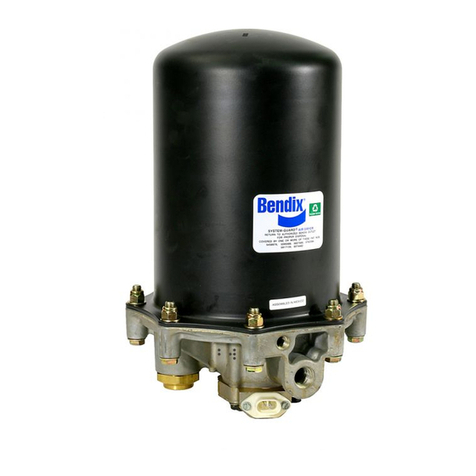
BENDIX
BENDIX AD-9 Mounting instructions
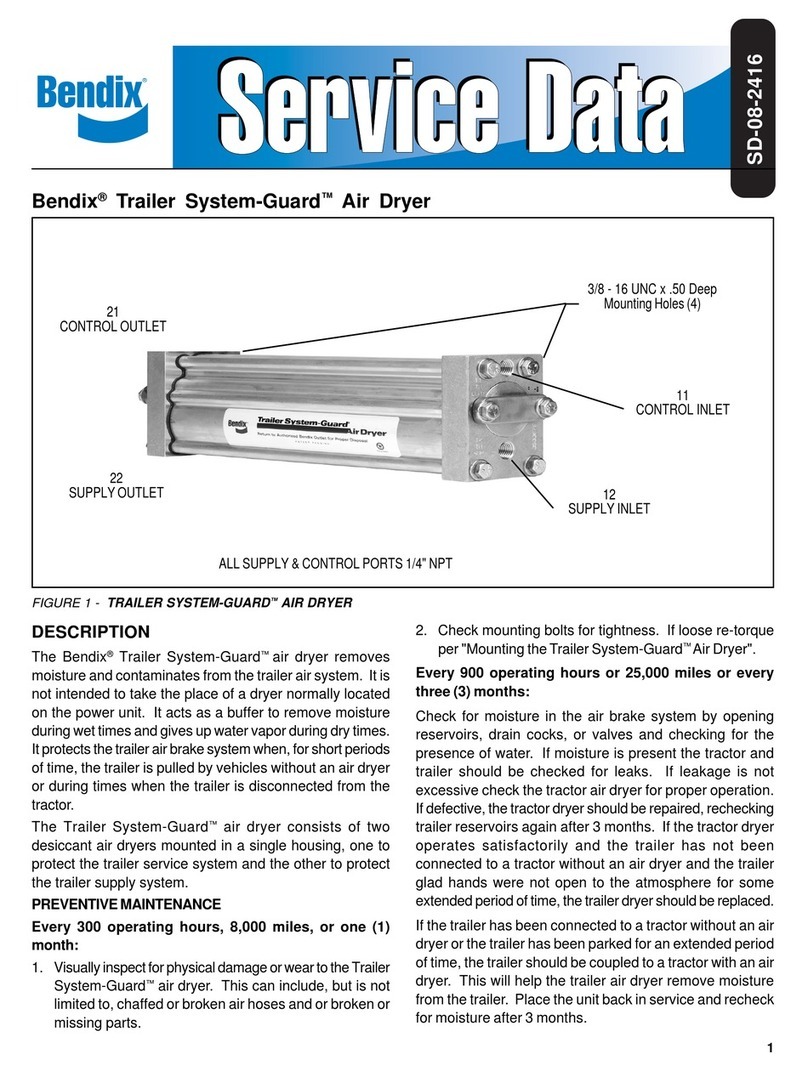
BENDIX
BENDIX TRAILER SYSTEM GUARD AIR DRYER User manual
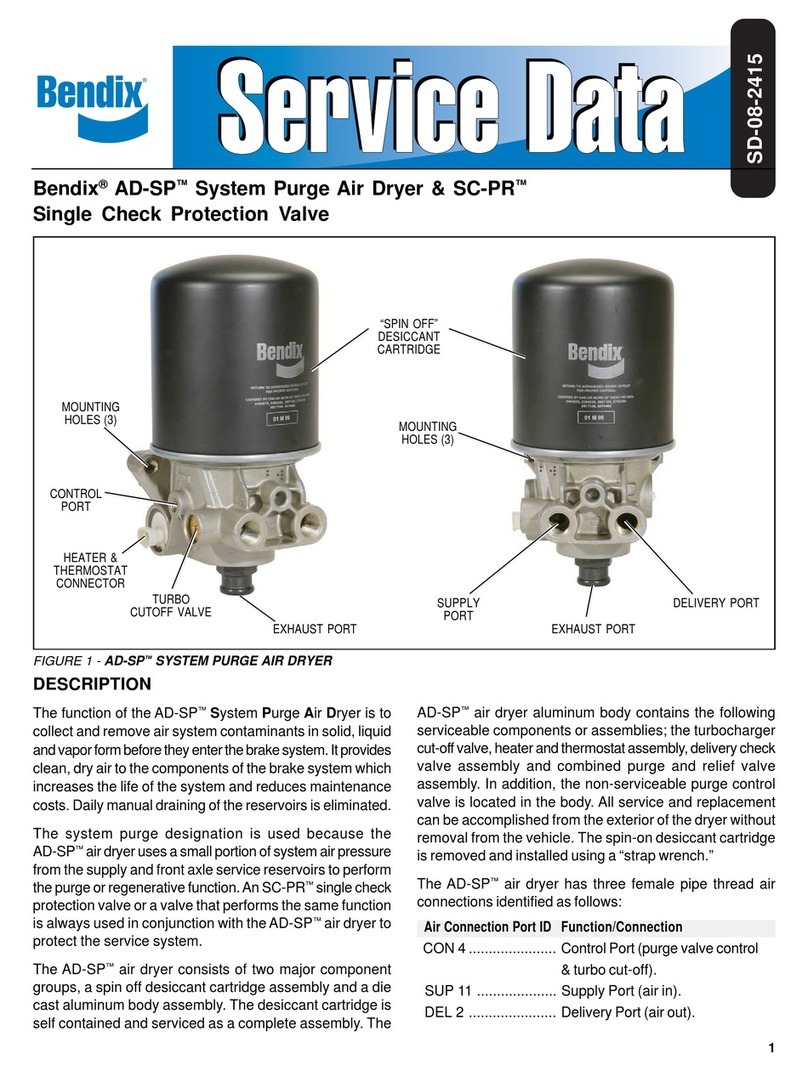
BENDIX
BENDIX AD-SP SYSTEM PURGE AIR DRYER User manual
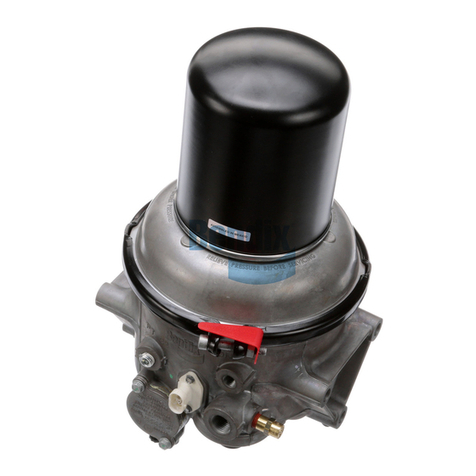
BENDIX
BENDIX AD-9si Mounting instructions
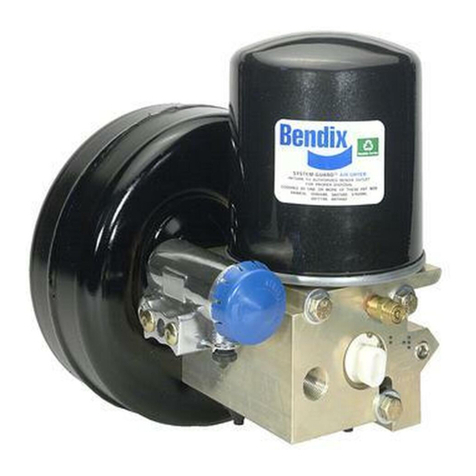
BENDIX
BENDIX AD-IS - User manual
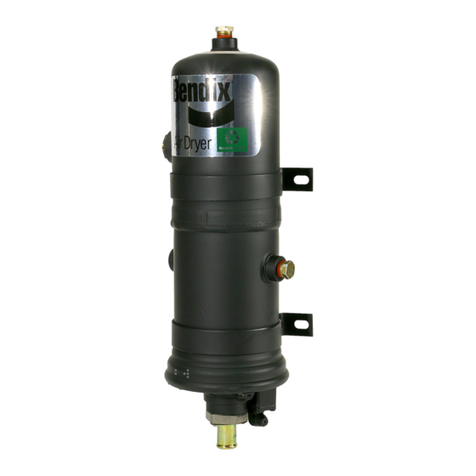
BENDIX
BENDIX AD-1 AIR DRYER User manual
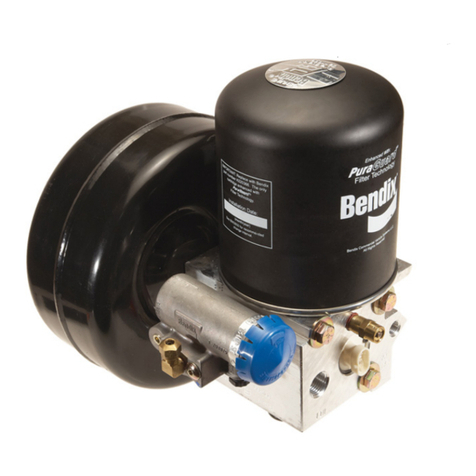
BENDIX
BENDIX AD-IS - Mounting instructions
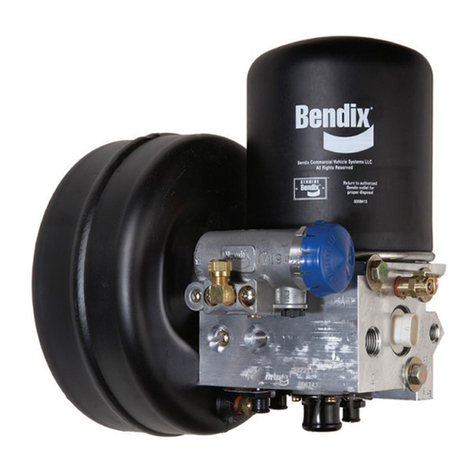
BENDIX
BENDIX SD-08-2418 User manual
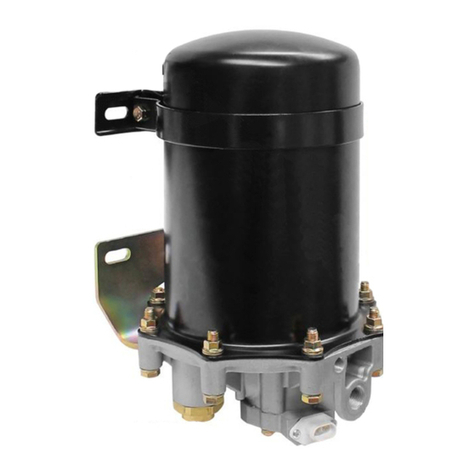
BENDIX
BENDIX AD-9 AIR DRYER User manual
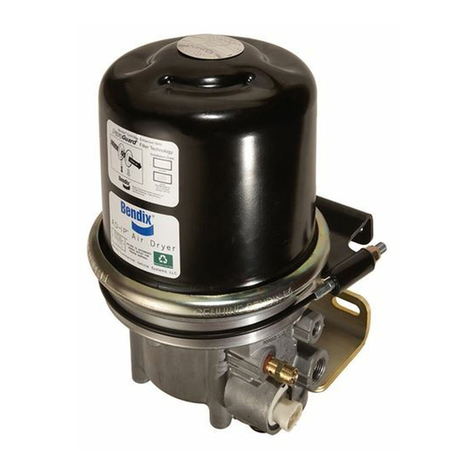
BENDIX
BENDIX AD-IP INTEGRAL PURGE AIR DRYER User manual
